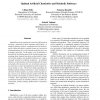Free Online Productivity Tools
i2Speak
i2Symbol
i2OCR
iTex2Img
iWeb2Print
iWeb2Shot
i2Type
iPdf2Split
iPdf2Merge
i2Bopomofo
i2Arabic
i2Style
i2Image
i2PDF
iLatex2Rtf
Sci2ools
JBI
2004
2004
Artificial Chemistries and Metabolic Pathways
Metabolism can be regarded as a network of biochemical reactions, connected via their substrates and products. A metabolic pathway is thus a coordinated series of reactions, and it is often described in symbolic terms, as a succession of transformations of a set of substrate molecules into a set of product molecules. In this paper, a set of molecules is described by the disjoint union of the chemical graphs representing them, chemical reactions are described by chemical reaction graphs, and metabolic pathways are computationally modeled by artificial chemistries. An artificial chemistry is represented as a directed graph with the chemical graphs that represent the sets of substrate and product molecules as nodes and applications of the chemical reaction graphs as arcs. We present simple algorithms for building optimal artificial chemistries, which transform a substrate chemical graph to a product chemical graph using a given set of chemical reaction graphs such that the least possible...
| Added | 31 Oct 2010 |
| Updated | 31 Oct 2010 |
| Type | Conference |
| Year | 2004 |
| Where | JBI |
| Authors | Liliana Félix, Francesc Rosselló, Gabriel Valiente |
Comments (0)

